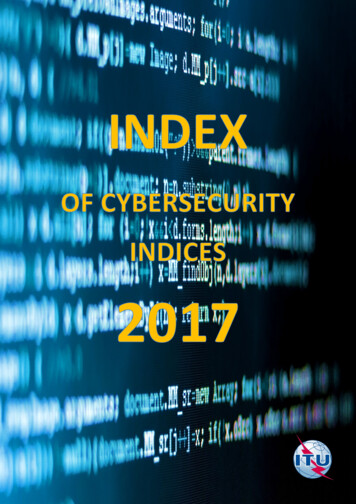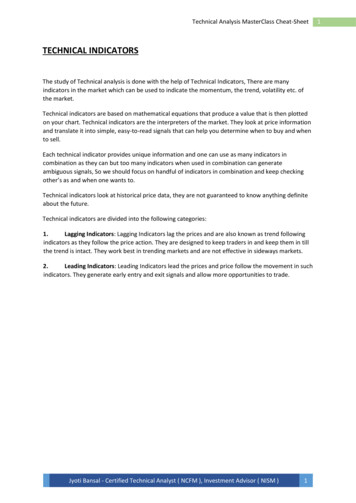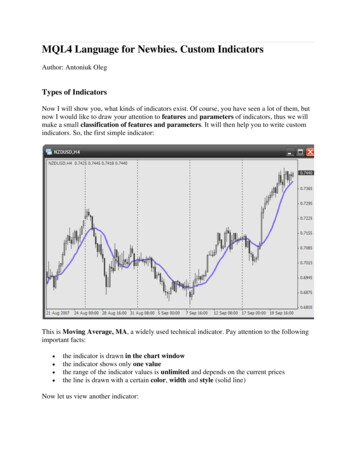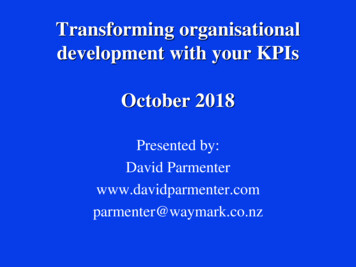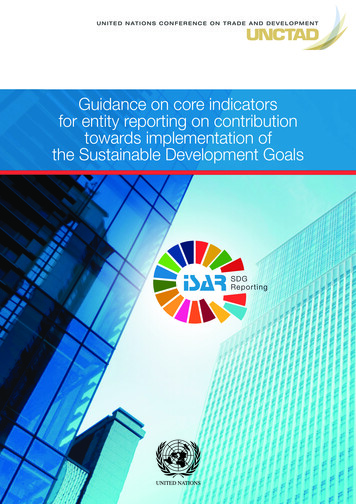
Transcription
U N I T E D N AT I O N S C O N F E R E N C E O N T R A D E A N D D E V E L O P M E N TGuidance on core indicatorsfor entity reporting on contributiontowards implementation ofthe Sustainable Development GoalsSDDGRee p orr t i n g
United NationsUnited Nations Conferenceon Trade and DevelopmentUNCTAD/DIAE/2019/1/Corr.1Sales No. E.19.II.D.1125 July 2019English onlyGuidance on Core Indicators for Entity Reporting on ContributionTowards Implementation of the Sustainable Development GoalsCorrigendumPage 4After (Royal Netherlands Institute of Chartered Accountants), insert Tetiana Iefymenko(Academy of Financial Management, Ukraine).GE.19-12704 (E)
United NationsUnited Nations Conferenceon Trade and DevelopmentUNCTAD/DIAE/2019/1/Corr.2Sales No. E.19.II.D.1128 January 2020English onlyGuidance on Core Indicators for Entity Reporting on Contributiontowards Implementation of the Sustainable Development GoalsCorrigendumPage 4, paragraph 5, line 24After (Royal Netherlands Institute of Chartered Accountants), insert Victoria Hurth(independent academic).GE.20-01227 (E)
U N I T E D N AT I O N S C O N F E R E N C E O N T R A D E A N D D E V E L O P M E N TGuidance on core indicatorsfor entity reporting on contributiontowards implementation ofthe Sustainable Development GoalsSDGRe p o r ti ngGeneva, 2019
2019, United NationsAll rights reserved worldwideRequests to reproduce excerpts or to photocopy should be addressed to the Copyright Clearance Centre atcopyright.com.All other queries on rights and licences, including subsidiary rights, should be addressed to:United Nations Publications300 East 42nd StreetNew York, New York 10017United States of AmericaEmail: publications@un.orgWebsite: un.org/publicationsThe designations employed and the presentation of material on any map in this work do not imply the expression ofany opinion whatsoever on the part of the United Nations concerning the legal status of any country, territory, city orarea or of its authorities, or concerning the delimitation of its frontiers or boundaries.0HQWLRQ RI DQ\ ƄUP RU OLFHQVHG SURFHVV GRHV QRW LPSO\ WKH HQGRUVHPHQW RI WKH 8QLWHG 1DWLRQV This publication has not been formally edited.United Nations publication issued by the United Nations Conference on Trade and Development.UNCTAD/DIAE/2019/1Sales No. E.19.II.D.11,6%1 } H,6%1 2
ContentsContentAcknowledgements . 4Main abbreviations .6I.Introduction: Rationale and objective .7II.Underlying principles of core SDG indicators selection and reporting .102.1.2.2.2.3.2.4III.Key methodological points .10Selection criteria .11Reporting principles .12Underlying accounting data .13Core SDG indicators for entities .16A.1. Economic area . 16A.1.A.2.A.3.A.4.B.Environmental area . B.1.B.2.B.3.% % C.Sustainable use of water .29Waste management.32Greenhouse gas emissions .372]RQH GHSOHWLQJ VXEVWDQFHV DQG FKHPLFDOV .40(QHUJ\ FRQVXPSWLRQ .41Social area .44C.1.C.2.C.3.C.4.D.Revenue and/or (net) value added.17Payments to the Government .20New investment/expenditures .21Local supplier/purchasing programmes .27Gender equality .44Human capital .47Employee health and safety . Coverage by collective agreements. Institutional area . D.1. Corporate governance disclosure . ' QWL FRUUXSWLRQ SUDFWLFHV. Annex I. Table of selected core SDG indicators . 3
Guidance on core indicators for entity reporting on the contribution towards the implementationof the Sustainable Development GoalsAcknowledgementsThis document was prepared by UNCTAD. Contributors to this guidance are asfollows: Tatiana Krylova (team leader), Yoseph Asmelash, Elena Botvina, IsabelGarza Rodríguez, Cristina Martinez de Silva, Felipe Morgado and Edvins Reisons.Dorothy Dillard, Vanessa McCarthy and Xiahui Xin provided administrative support.UNCTAD acknowledges with appreciation the excellent contribution of Ariela Caglioof Bocconi University, who worked on the drafting of the document based on theconcept on core Sustainable Development Goal (SDG) indicators for enterprises,launched by UNCTAD at its fourteenth quadrennial conference in Nairobi, Kenya,in 2016, followed by deliberations of ISAR 32, 33 and 34 sessions on this topic,and her own extensive research. This version of the guidance has also beenPRGLƄHG WR UHƅHFW FRPPHQWV DQG GHOLEHUDWLRQV RI WKH WKLUW\ ƄIWK VHVVLRQ RI ,6 5 The work was carried out under the overall direction of James Zhan, Director,Division on Investment and Enterprise.The guidance has been prepared in collaboration with the members of theConsultative Groups on SDG reporting by enterprises, annually convened by81&7 ' VLQFH WKH WKLUW\ VHFRQG VHVVLRQ RI ,6 5 WR GHOLEHUDWH SURJUHVVLYHO\ RQ the concept, criteria of selection, reporting principles and draft guidance on coreindicators, prepared by the UNCTAD secretariat. In this regard, UNCTAD wouldlike to express its appreciation to the following experts, who at different stages ofelaboration of this document and underlying issues provided valuable arguments,inputs and comments:Ahmed Abbar (Ministry of Finance, Morocco), Mario Abela (Gather, United Kingdomof Great Britain and Northern Ireland and World Business Council for SustainableDevelopment (WBCSD)), Anne Adrian (Institute of Chartered Accountants ofScotland), Lowri Angharad Rees (United Nations Environment Programme), Scott%DUORZ %ULWLVK 7HOHFRP :LP %DUWHOV .30* 6RƄD %DUWKROG\ 3ULQFLSOHV IRU Responsible Investment, UNPRI), Pietro Bertazzi (Global Reporting Initiative (GRI)),Anais Blasco (World Business Council for Sustainable Development (WBCSD)),/XNH %ORZHU &OLPDWH 'LVFORVXUH 6WDQGDUGV %RDUG &'6% QQH /HRQRUH %RIƄ (World Business Council for Sustainable Development (WBCSD)), Raquel Breda(Ministry of Environment, Brazil), Ole Buhl (ATP), Andrei Busuioc (World Bank),Jessica Chan (Department of Economic and Social Affairs (DESA)), Peter Clark(International Accounting Standards Board (IASB)), Catherine Crowsley (BusinessFrameworks Directorate, UK), Vania da Costa Borgerth (Brazilian DevelopmentBank (BNDES), Brazil), Hermance de la Bastide (Pernod Ricard), Mark Didden(World Business Council for Sustainable Development (WBCSD)), James Donovan(ADEC Innovations), Eric Dugelay (Deloitte), Robin Edme (Group of Friends ofParagraph 47), Gerard Ee (Institute of Singapore Chartered Accountants), DritanFino (Ministry of Finance, Albania), Anne Gadegaard (Novo Nordisk), Jennie Gleed&'3 -LPP\ *UHHU VVRFLDWLRQ RI &KDUWHUHG &HUWLƄHG FFRXQWDQWV && /RLV Guthrie (Climate Disclosure Standards Board (CDSB)), Alasdair Hedger (ClimateDisclosures Standards Board (CDSB)), Hillary Green (United Nations EnvironmentProgramme), Robert Hodgkinson (Institute of Chartered Accountants, UnitedKingdom), Lieneke Hoeksma (Statistics Netherlands), Paul Hurks (RoyalNetherlands Institute of Chartered Accountants), Lorenza Jachia (EconomicCommission for Europe (ECE), Kathryn Jackson (The Prince’s Accounting for6XVWDLQDELOLW\ 3URMHFW 6HHPD -DPLO 2p1HLOO %XVLQHVV )UDPHZRUNV 'LUHFWRUDWH 8QLWHG .LQJGRP 1DQF\ .DPS 5RHODQGV ,QWHUQDWLRQDO XGLWLQJ DQG VVXUDQFH Standards Board (IAASB), Olga Kapustina (Kyiv National Economic University),4
AcknowledgementsVincent Kaufmann (Ethos Foundation), Austin Kennedy (World Business Councilfor Sustainable Development (WBCSD), Drissa Koné (Ministry of Economy andFinance, Côte d’Ivoire), Monika Kumar (World Bank), Nordine Lazrak (Departmentof International Cooperation in State Finance and Territorial Communities,Morocco), Liudmyla Lovinska (Financial Research Institute, Academy of FinancialManagement, Ukraine), Tiina Luige (Economic Commission for Europe (ECE),Daniel Malan (Stellenbosch University Business School), Isabella Marras (UnitedNations Environment Programme), Richard Martin (Association of Chartered&HUWLƄHG FFRXQWDQWV && ODQ 0F*LOO 3Z& /L]ZL 1NRPEHOD 3HUPDQHQW Mission of South Africa in Geneva), Jennifer Park (Economic Commission forEurope (ECE), Dance Pesce (Valparaiso Catholic University, Chile), Philippe3HXFK /HVWUDGH ,QWHUQDWLRQDO ,QWHJUDWHG 5HSRUWLQJ &RXQFLO ,,5& 'HERUD Ponce (Permanent Mission of Guatemala to the United Nations in Geneva),Charlotte Portier (Global Reporting Initiative (GRI)), Tracey Rembert (Ceres), GhitaRoelans (International Labour Organization (ILO), Richard Rothenberg (GlobalA.I.), Tatyana Rybak (Ministry of Finance, Belarus), Rosario Sánchez Marcos(Sustainability Management, Iberdrola), Matthias Schmidt (International IntegratedReporting Council (IIRC), Michel Scholte (True Price), Louise Scott (PwC), PaulScott (Corporate Register), Rachid Sghier (Department of Centralization of StateAccounts, Morocco), Lisa Sherk (Blue Orchard), Leonid Shneydman (Ministry ofFinance, Russian Federation), Emily Sims (International Labour Organization (ILO),Emmelin Skelton (PwC), Sophie Pagnetti (KPMG), Neil Stevenson (InternationalIntegrated Reporting Council (IIRC), Nadina Stodiek (Blue Orchard), Joyce Tang,QVWLWXWH RI 6LQJDSRUH &KDUWHUHG FFRXQWDQWV ,6& -RHO 7DQ 7RUUHV 3URIHVVLRQDO Regulatory Board of Accountancy, Philippines), Wolfram Tertschnig (Ministry ofAgriculture, Forestry, Environment and Water Management, Austria), Jane ThostrupJagd (independent expert), Ralph Thurm (Reporting 3.0), Elisa Tonda (UnitedNations Environment Programme), Alexander Trepelkov (Department of EconomicDQG 6RFLDO IIDLUV '(6 6HEDVWLHQ 7UXIIHU )HGHUDO 2IƄFH IRU WKH (QYLURQPHQW Switzerland), Chichi Umesi (SDG Lab), Jeffrey Unerman (Royal Holloway Universityof London), Victor Valido (United Nations Environment Programme), Cornelis vander Lugt (Stellenbosch University Business School, South Africa), Ian van der Vlugt(CDP), Pierre Wanssy (Cabinet Pierra Wanssy et Associées), Reinhard Weissinger(International Organization for Standardization (ISO)), Yuki Yasui (United NationsEnvironment Programme Finance Initiative).5
Guidance on core indicators for entity reporting on the contribution towards the implementationof the Sustainable Development GoalsMain abbreviations6FTE)XOO WLPH HTXLYDOHQWGAAPGenerally accepted accounting principlesGHGGreenhouse gasGRIGlobal Reporting InitiativeIAEG-SDGs,QWHU JHQF\ DQG ([SHUW *URXS RQ 6XVWDLQDEOH 'HYHORSPHQW Goal IndicatorsIASInternational Accounting StandardIFRSInternational Financial Reporting StandardIIRCInternational Integrated Reporting CouncilODSR]RQH GHSOHWLQJ VXEVWDQFHSDGSustainable Development GoalSME6PDOO DQG PHGLXP VL]HG HQWHUSULVHSNASystem of National AccountsTCFD7DVN )RUFH RQ &OLPDWH UHODWHG )LQDQFLDO 'LVFORVXUHV
I.Introduction: Rationale and objectiveI. Introduction: Rationaleand objective1.,Q 0HPEHU 6WDWHV RI WKH 8QLWHG 1DWLRQV DGRSWHG WKH JHQGD for Sustainable Development, containing 17 Sustainable Development Goals(SDGs) and 169 targets.1 In resolution 70/1, the General Assembly statedthat the Goals and targets would be followed up and reviewed using a setof global indicators focused on measurable outcomes. Consequently, the,QWHU JHQF\ DQG ([SHUW *URXS RQ 6XVWDLQDEOH 'HYHORSPHQW *RDO ,QGLFDWRUV , (* 6'*V ZDV HVWDEOLVKHG WR GHYHORS D JOREDO LQGLFDWRU IUDPHZRUN WR monitor implementation of the 2030 Agenda. Member States are in theprocess of developing their national indicators in line with the 2030 Agendabut taking into account national circumstances.2 )XOO} GHYHORSPHQW RI WKH indicator framework is a process that requires time and the possibility ofUHƄQHPHQW DV NQRZOHGJH DQG GDWD DYDLODELOLW\ LPSURYH 2.7KH UHSRUW RI WKH , (* 6'*V UHTXLUHV JOREDO PRQLWRULQJ WR EH EDVHG WR WKH greatest possible extent, on comparable and standardized national data,REWDLQHG WKURXJK ZHOO HVWDEOLVKHG PHFKDQLVPV IRU FRXQWU\ UHSRUWLQJ WR WKH LQWHUQDWLRQDO VWDWLVWLFDO V\VWHP (IIRUWV VKRXOG EH PDGH WR ƄOO GDWD JDSV and improve international comparability through the increased adoptionof internationally agreed standards at the national levels, strengthening ofnational statistical capacities and improved reporting mechanisms.3.These developments have a direct impact on the accounting and reportingDJHQGD 6'* VXVWDLQDEOH FRQVXPSWLRQ DQG SURGXFWLRQ LQ LWV WDUJHW} explicitly encourages companies, especially large and transnationalcompanies, to adopt sustainable practices and to integrate sustainabilityinformation into their reporting cycles. Indicator 12.6.1 requires data on thenumber of companies publishing sustainability reports (further on 12.6.1).Several other SDG indicators refer to data already being provided by manyenterprises in their reports, such as on the use of energy and water, carbondioxide emissions, waste generation and recycling, and to human resourcemanagement, gender equality and community development, among others.4.Company reporting may therefore be an important data source for the newlyestablished SDGs monitoring framework. As a primary source of informationon company performance, reporting can enrich and enhance Goalsmonitoring mechanisms by providing stakeholders such as Governmentsand capital providers with the means to assess the economic, environmentaland social impacts of companies on sustainable development. Relevant data on companies’ contribution towards the SDGs is criticalIRU DVVHVVLQJ WKH SURJUHVV RI 6'* LPSOHPHQWDWLRQ HQKDQFLQJ WKH 6'* RULHQWHG FRUSRUDWH JRYHUQDQFH PHFKDQLVPV GHFLVLRQ PDNLQJ E\ LQYHVWRUV and other key stakeholders, as well as promoting behavioural change at theenterprise level. The SDG agenda requires comparable and reliable dataUHƅHFWLQJ FRPSDQLHVp SHUIRUPDQFH WRZDUGV WDUJHWV DQG LQGLFDWRUV DJUHHG 1United Nations General Assembly, Transforming our world: The 2030 Agenda for Sustainable Development, 2FWREHU 5(6 DYDLODEOH DW ZZZ XQ RUJ HQ GHYHORSPHQW GHVD SRSXODWLRQ PLJUDWLRQ generalassembly/docs/globalcompact/A RES 70 1 E.pdf [accessed 11 January 2019].2(FRQRPLF DQG 6RFLDO &RXQFLO 5HSRUW RI WKH LQWHU DJHQF\ DQG H[SHUW JURXS RQ VXVWDLQDEOH GHYHORSPHQW JRDO indicators. New York: United Nations (2016). E/CN.3/2016/2.7
Guidance on core indicators for entity reporting on the contribution towards the implementationof the Sustainable Development Goalsby Member States of the United Nations. This in turn gives a new impetustowards aligning the harmonization of sustainability reporting with the SDGmonitoring framework.6.In response to this challenge in 2016, during its fourteenth quadrennialconference in Kenya, UNCTAD launched its initiative on selecting a limitednumber of core SDG indicators for company reporting.7.The Guidance was prepared by UNCTAD in accordance with the agreedFRQFOXVLRQV RI WKH WKLUW\ IRXUWK VHVVLRQ RI WKH ,QWHUJRYHUQPHQWDO :RUNLQJ Group of Experts on International Standards of Accounting and Reporting(ISAR), which in 2017 had requested UNCTAD to develop a guidingdocument on a limited number of core indicators for entity reporting, alignedwith SDGs. The Guidance is based on elaborations on this issue over thelast three years during the annual sessions3 of ISAR and at the intersessionalforums, including Consultative Group meetings convened by UNCTAD from WR During these discussions, a limited number of core SDG indicators wereLGHQWLƄHG DQQH[ , EDVHG RQ NH\ UHSRUWLQJ SULQFLSOHV VHOHFWLRQ FULWHULD PDLQ reporting frameworks and company reporting practices. These core indicatorsare intended as a starting or entry point in relation to sustainability and SDGreporting by enterprises, and therefore, they would represent the minimumdisclosures that companies would need to provide in order for Governments tobe able to evaluate the contribution of the private sector to the implementationof SDGs. However, they do not attempt to preclude companies from providingmore information in a qualitative or quantitative form. The core indicators do notFRYHU DOO 6'* PDFUR OHYHO LQGLFDWRUV EXW UHSUHVHQW D VHOHFWHG QXPEHU RI FRPSDQ\ indicators that have been considered indispensable to assess the economic,environmental, social and governance impacts of companies’ activities, whichalready could be found in their reports and in reporting frameworks.9.38The objective of this Guidance is to provide practical information on how theseindicators could be measured in a consistent manner and in alignment withcountries’ needs on monitoring the attainment of the SDG agenda. It isintended to serve as a tool to assist Governments to assess the private sectorcontribution to the SDG implementation and to enable them to report on SDGindicator 12.6.1. It also intends to assist entities to provide baseline data onsustainability issues in a consistent and comparable manner that would meetFRPPRQ QHHGV RI PDQ\ GLIIHUHQW VWDNHKROGHUV RI WKH 6'* DJHQGD ƄJXUH ,W DOVR HQYLVDJHG WKDW WKH *XLGDQFH ZRXOG IDFLOLWDWH FDSDFLW\ EXLOGLQJ LQ WKH DUHD of SDG reporting in member States at the country and company level as partof ongoing UNCTAD projects in this area. The Guidance will be updated asneeded based on the results of its practical application.Issues note ISAR 33, Enhancing the role of reporting in attaining the Sustainable Development Goals:Integration of environmental, social and governance information into company reporting, available atKWWSV XQFWDG RUJ PHHWLQJV HQ 6HVVLRQDO'RFXPHQWV FLLLVDUG BHQ SGI LVVXHV QRWH ,6 5 (QKDQFLQJ comparability of sustainability reporting: Selection of core indicators for company reporting on the contributiontowards the attainment of the Sustainable Development Goals, available at https://unctad.org/meetings/en/6HVVLRQDO'RFXPHQWV FLLLVDUG BHQ SGI LVVXHV QRWH ,6 5 (QKDQFLQJ WKH FRPSDUDELOLW\ RI VXVWDLQDELOLW\ reporting: Selection of core indicators for entity reporting on the contribution towards the attainment ofthe Sustainable Development Goals, available at FLLLVDUG BHQ SGI
I.Introduction: Rationale and objectiveFigure 1.KEY USERS OF THE CORE SDG INDICATORS BY ENTITIESSOCIETYAT LARGECAPITALPROVIDERSCORE SDGINDICATORSOTHER KEYSTAKEHOLDERSGOVERNMENTAGENCIESSource: UNCTAD.9
Guidance on core indicators for entity reporting on the contribution towards the implementationof the Sustainable Development GoalsII. Underlying principlesof core SDG indicatorsselection and reporting2.1. Key methodological points10. The Guidance is based on the main methodological considerationsoutlined below.11. Simplicity: 7KH *XLGDQFH LV LQWHQGHG WR EH D XVHU IULHQGO\ WRRO IRU SUHSDUHUV of information (both at legal entity and consolidated levels) and for differentusers, in the public and the private sectors, for understanding entities’performance and impact across the core sustainability/SDG indicators.412. Baseline approach: The selected core indicators are common to anybusiness, as they focus on a rational use of resources (such as water,energy, and air, and waste reduction), social issues related to humancapital development and gender equality; as well as governance andtransparency, which is part of the regular operational business cycle. TheGuidance takes into consideration entities’ practices and the fact thatentities are at different stages in their sustainability reporting journey. It isnot aimed at creating new norms; rather its objective is to select commonsustainability indicators based on entities’ current reporting practicesand leading reporting frameworks (IFRS, IIRC, SASB, GRI, GlobalCompact and others); it provides a measurement methodology for eachof the selected core indicators and suggests accounting sources of datacollection. It remains up to the individual businesses in different operatingcontexts to start from these baseline indicators and provide additionalLQIRUPDWLRQ DV QHHGHG WR UHƅHFW WKHLU VSHFLƄF 6'* UHODWHG SUDFWLFHV DQG PRUH VSHFLƄF QHHGV RI XVHUV SDUWLFXODUO\ WKRVH UHSUHVHQWLQJ LQYHVWRUV and other capital providers.13. Emphasis on quantitative indicators: Although the importance of qualitative,QDUUDWLYH GLVFORVXUH DQG RI XQGHUVWDQGLQJ WKHVH LQGLFDWRUV LQ D VSHFLƄF FRQWH[W are acknowledged, the Guidance does not discuss narrative disclosures andfocuses on quantitative indicators.14. For each reporting indicator (micro level), a most relevant SDG indicator(macro level) and its metadata guidance is referred to, in order to facilitatethe alignment between the micro- and macro-level indicators. For, instance,in the case of core indicator D.1.2 Number and percentage of womenERDUG PHPEHUV UHIHUHQFH LV PDGH WR 6'* LQGLFDWRU 3URSRUWLRQ RI ZRPHQ LQ PDQDJHULDO SRVLWLRQV ,Q VRPH FDVHV D PDFUR OHYHO LQGLFDWRU LV referred to for more than one reporting indicator. In other cases, there isQR VWUDLJKWIRUZDUG UHODWLRQ EHWZHHQ WKH UHSRUWLQJ LQGLFDWRU DQG WKH PDFUR level indicator mentioned, but it represents the best possible alignmentwith the SDG macro level, and the usefulness of the reporting indicator410The Guidance aims at achieving simplicity within reasonable parameters, as sustainable development andcertain subjects within this area are more complex than others.
II.Underlying principles of core SDG indicators selection and reportingwill be further explored through pilot testing. The alignment between thePLFUR DQG PDFUR OHYHO LQGLFDWRUV WDNHV LQWR DFFRXQW WKH DSSURDFK RI D statistical framework jointly developed by the European Community, IMF,OECD, United Nations and the World Bank, titled “The System of NationalAccounts” (SNA).6 SNA states that there would be considerable analyticalDGYDQWDJHV LQ KDYLQJ PLFUR GDWDEDVHV WKDW DUH IXOO\ FRPSDWLEOH ZLWK WKH corresponding macroeconomic accounts for sectors or the total economy,and thanks to IT improvements, it becomes progressively easier to derivedata from administrative and business records. While it recognizes thatIRU YDULRXV UHDVRQV LW PD\ EH GLIƄFXOW LI QRW LPSRVVLEOH WR DFKLHYH PLFUR databases and macroeconomic accounts that are fully compatible witheach other in practice, nevertheless, as a general objective, the concepts,GHƄQLWLRQV DQG FODVVLƄFDWLRQV XVHG LQ HFRQRPLF DFFRXQWLQJ VKRXOG DV IDU as possible, be the same for both the micro and macro level to facilitate theinterface between the two kinds of data.2.2. Selection criteria Selection of the core indicators is based on the following criteria: Relevance to at least one Sustainable Development Goal monitoringindicator. Based on existing key initiatives or reporting frameworks and/or shouldbe found in corporate reports. Universality (applicable to all reporting entities). Comparability across industries. Ability to address issues over which an entity has control and for which itgathers data (incremental approach) ELOLW\ WR IDFLOLWDWH FRQYHUJHQFH RI ƄQDQFLDO DQG QRQ ƄQDQFLDO UHSRUWLQJ principles and data. Capability of consistent measurement. Suitability for consolidated reporting and legal entity reporting.16. As previously mentioned, the core indicators will be pilot tested at theFRXQWU\ OHYHO ZLWK D YLHZ WR FRQƄUPLQJ WKHLU XVHIXOQHVV DQG IHDVLELOLW\ V D result, some indicators might be replaced, added or eliminated. The workwill also consider further possible adjustments in the SDG framework ofPDFUR OHYHO LQGLFDWRUV ,W LV LPSRUWDQW WR HPSKDVL]H WKDW WKH REMHFWLYH LV to have a set of core indicators applicable to all companies. However, it isunderstood that certain indicators might not be applicable to some entities.For instance, this might be the case with corporate governance indicatorsfor some SMEs. Pilot testing at the country level will provide useful evidencein this regard. )XUWKHU UHƄQHPHQW LQ WKLV DUHD FRXOG EH HQYLVDJHG EDVHG RQ WKH IHHGEDFN IURP WKH SUDFWLFDO DSSOLFDWLRQ RI the suggested core indicators.6System of National Accounts, New York, 2009.11
Guidance on core indicators for entity reporting on the contribution towards the implementationof the Sustainable Development Goals2.3. Reporting principles17. The Guidance is based on the consideration that the reporting frameworkfor the SDG indicators should be consistent with the existing institutionalIRXQGDWLRQV IRU WKH LQWHUQDWLRQDO ƄQDQFLDO UHSRUWLQJ V\VWHP 6XFK D IUDPHZRUN QHHGV WR HQVXUH WKH FRKHUHQFH RI ƄQDQFLDO DQG QRQ ƄQDQFLDO UHSRUWLQJ models and allow for the consistent integration of sustainability informationinto company reporting cycles. This includes relevance of the internationalƄQDQFLDO UHSRUWLQJ FRQFHSWXDO IUDPHZRUN WR 6'* UHSRUWLQJ FRQVLVWHQF\ in measurement methodology and data comparability, clarity of reportingboundaries and incremental approach7. Materiality vs universality: One key consideration related to the principle ofPDWHULDOLW\ LV WKDW GHƄQLQJ PDWHULDOLW\ DV DQ HQWLW\ VSHFLƄF DVSHFW PD\ FUHDWH D FRQƅLFW ZLWK WKH FULWHULRQ RI XQLYHUVDOLW\ ,Q WKH FRQWH[W RI 6'* UHSRUWLQJ PDWHULDOLW\ KDV D QHZ GLPHQVLRQ LQ DGGLWLRQ WR LWV HVWDEOLVKHG GHƄQLWLRQ GRSWLRQ RI WKH *RDOV UHTXLUHG PXOWL VWDNHKROGHU FRQVXOWDWLRQV DQG DOO parties agreed that certain aspects of economic, environmental and socialactivities were material to them. Therefore, the selection of core SDGindicators relies on the idea that the targets are integrated into the currentmateriality assessments of companies and thus guide the sustainabilityGLVFORVXUH IUDPHZRUN ,W LV DOVR FRQVLVWHQW ZLWK WKH 7DVN )RUFH RQ &OLPDWH UHODWHG )LQDQFLDO 'LVFORVXUHV 7&)' UHSRUW RQ FOLPDWH UHODWHG ƄQDQFLDO ULVN GLVFORVXUH ZKLFK LQGLFDWHV FOLPDWH UHODWHG ULVN DV D QRQ GLYHUVLƄDEOH ULVN WKDW affects nearly all industries.919. Furthermore, enhanced transparency is required on the materialityassessment process that should accompany the reporting of data on theFRUH 6'* LQGLFDWRUV ,Q LWV &RQVXOWDWLRQ 'RFXPHQW RQ WKH 8SGDWH RI WKH 1RQ %LQGLQJ *XLGHOLQHV RQ 1RQ )LQDQFLDO 5HSRUWLQJ WKH (XURSHDQ &RPPLVVLRQ10UHIHUV WR D GRXEOH PDWHULDOLW\ SHUVSHFWLYH D ƄQDQFLDO PDWHULDOLW\ ZKLFK considers the company’s development, performance and position and hasthe investors as the primary audience and (b) environmental and socialmateriality, which considers the impact of the company’s activities and hasconsumers, civil society, employees and a growing number of investors asthe primary audience.20. Clarity of reporting boundaries: &RQVLVWHQF\ ZLWK LQWHUQDWLRQDO ƄQDQFLDO reporting standards makes it important to disclose the basis of determiningthe boundaries of the reporting entity and other assumptions and methodsthat underpin sustainability reporting. In some jurisdictions, internationalƄQDQFLDO UHSRUWLQJ VWDQGDUGV PD\ QRW EH UHTXLUHG IRU WKH SUHSDUDWLRQ RI OHJDO HQWLW\ ƄQDQFLDO VWDWHP
(independent academic). United Nations UNCTAD /DIAE/2019/1/Corr.2 United Nations Conference on Trade and Development Sales No. E.19.II.D.11 28 January 2020 English only . UNITED NATIONS CONFERENCE ON TRADE AND DEVELOPMENT . (International Organization for Standardization (ISO)), Yuki Yasui (United Nations .

